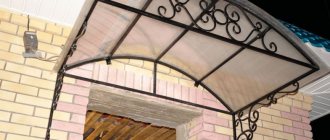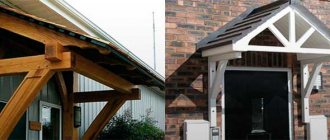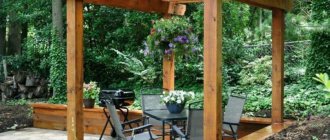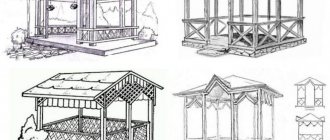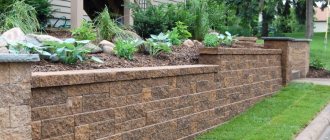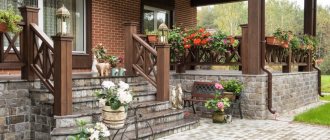The forged visor is a functional and practical design, characterized by reliability, presentable and original design. There are many types of these products. The criterion for dividing into groups is shape, manufacturing technology, location.
In accordance with the last sign, canopies above the entrance and above the porch are distinguished.
The structures of the first group perform a practical function: they protect the moving parts of doors, gates and gates from harmful weather influences. In addition, canopies give the facade a complete look and are an excellent decorative element.
The article is devoted to structures of the second type. Forged canopies over the porch protect the entrance to the building from unpleasant weather surprises and mechanical influences. Such structures are perfect for any style of home and give the building a complete look.
Purpose of the entrance canopy
If we talk about the structure as a whole, the canopy or canopy over the porch consists of a frame and roofing material (cladding). There may also be support posts that support the outer edge of the canopy. They are an optional element. They are needed when there is no confidence that the structure without additional supports will be able to retain precipitation.
Canopy over the entrance: general device
Precipitation generally means snow. In regions with a lot of snow, you can either make the slope of the canopy steep so that the snow melts quickly, or install additional supports. You can do both, as is usually done - the margin of reliability/strength reassures and instills confidence.
Frame and stand materials
The frame and supports of the canopy over the front door are made from:
- metal: steel angle;
- metal strips;
- round pipe;
- profiled pipe;
Rolled metal of various types and wood are two materials that are used in the construction of a canopy over the porch
The most popular material recently for making the frame of a canopy over a porch is profiled pipe. With equal dimensions and wall thickness with a round pipe (if we compare the diagonal and diameter), the profile has greater rigidity. At the same time, it comes in a variety of sections - a square and a rectangle with different sides, it can be bent into arcs, it is easier to weld and attach to walls, it goes well with elements of traditional or cold forging, and its durability is the same as other steel products. In general, it is the profiled pipe that is in favor today.
What is the lining of the canopy over the porch made of?
If we talk about materials for cladding the canopy over the porch, there is a very wide choice. Very often the canopy over the entrance to the house is made of the same material as the roof. And this is correct, since in this case the result is a harmonious design of the house. With this solution, any roofing material is used:
- slate;
- metal tiles; The canopy over the porch and the roof are covered with the same material - tiles
The style must also match
Soft tiles on the porch and roof
Metal tiles on the roof and canopy
When style and material match, a harmonious look is obtained - soft bitumen shingles;
- natural tiles;
The second option is to use the material that is used in the fence. In this case, both the design style and decorative elements should be recognizable. This will create a single ensemble with the site. Here the materials can be like this:
- slate (usually flat, but not a fact);
- corrugated sheeting;
- polycarbonate;
- wooden plank.
And the third option for designing a canopy over the porch is to install a canopy that is “neutral” in style and material. This may include:
- wooden canopy;
- polycarbonate (not necessarily cellular polycarbonate, there is also sheet polycarbonate);
- sheet plastic;
- glass.
Polycarbonate combined with wood
Looks good
A long canopy not only over the porch, but also over the entrance path
Glass is used less often. It is necessary to use reinforced types such as triplex, and not only are they expensive, they also weigh heavily, so additional suspensions or powerful support columns are definitely required. And if you consider that sheet polycarbonate or plastic is not much different in appearance from glass, it becomes clear why glass is unpopular.
Shapes of canopies
There are more than a dozen forms of canopies over the front door. The easiest one to make is a lean-to canopy. Requires a minimum of effort and materials, and can look very good. The downside is that when the snow melts, a snowdrift will end up in front of your door and will urgently need to be removed. Other models with slopes tilted forward suffer from the same “disease”. These are excellent options for regions with little snow in winters, but with hot sun - not quite for our latitudes. Although, if you are not afraid of the need for urgent snow removal, you can do any of the options.
Shapes and names of canopies over the porch
It’s a little more difficult to make a gable canopy (this is the house) and a simple arch. They are good because the melted snow ends up on the sides of the entrance and, even if there is a large amount of it, there is no need to urgently remove it. So for regions with a lot of snow, these are the best models.
Materials
Different types of coatings are harmoniously combined with forged patterns.
Polycarbonate (a type of plastic)
Inexpensive, but at the same time a very attractive option.
Polycarbonate has many advantages:
- flexibility . Perfect for making arched canopies;
- the widest range of bright, rich colors . Plastic is painted three-dimensionally, so it does not lose color when scratched;
- transparency . A transparent or translucent visor seems light, airy and therefore looks very impressive;
- ease of processing . Soft material can be easily cut and drilled with hand tools.
The disadvantages are:
- softness. The downside of ease of processing is the tendency to scratch. Twigs, leaves, various debris blown by the wind - all this leaves marks on the coating, so that it loses its luster over time;
- high coefficient of thermal expansion.
Polycarbonate changes significantly in size with temperature fluctuations. Therefore, when fastening, they leave temperature gaps - without them, the material will crack.
Corrugated sheet
Thin profiled steel coated with colored polymer.
Under normal conditions, profiled sheets with a polyester coating are used; in areas with polluted air or near salty bodies of water, they are used with pural or plastisol (in the northern regions). Corrugated sheeting is stronger and more durable than polycarbonate. Moreover, thanks to the polymer coating, it can also have any color.
Use on arched canopies is allowed, but with caution: when bending, the coating may be damaged, as a result of which the steel will begin to corrode.
Metal tiles
These are also steel sheets with a polymer coating, but they are not stamped with a wave, but with a relief that imitates ceramic tiles. For this, thinner metal is used, but metal tiles look more interesting than corrugated sheets. At the same time, complex corrugation limits the scope of application of this material to flat surfaces.
Glass
Used in designer visors. A special type is used - tempered glass with a polymer layer (triplex): with strong impacts, it cracks into small safe fragments, kept from crumbling by an adhesive polymer. The disadvantages of the material are high cost and fragility.
Laminated glass triplex
Galvanization
This budget cover is suitable for a simple pseudo-forged visor. You can give it an interesting look, for example, by cutting out triangles on the leading edge and bending them at an angle of 90 degrees. Galvanization is suitable for making an arched canopy.
If the coating is assembled from several fragments, metal products are laid with an overlap, polycarbonate is joined using an H-shaped profile.
How to connect the canopy over the porch and the wall of the house
One of the most difficult moments is to join the covering of the canopy over the porch so that water does not flow down the wall. Usually, standard methods of joining the roof are used - using a bumper strip. This method is suitable for any roofing material, as well as sheet metal and wood. You just need to choose the right color. There are two approaches: matching the wall or matching the roof covering of the canopy. The options are equal, so it’s up to you to decide/choose.
How to connect a canopy to a wall
A groove (5-7 mm deep) is made under the fender strip in the wall. The edge of the plank is inserted into the recess, secured, and the seam is sealed with moisture-resistant sealant for external use. The other edge of the strip rests on the roofing material. When water runs down the wall, it flows onto the plank, from it, bypassing the joint, onto the roofing material and further into the storm drain system or directly to the ground - depending on how it’s done.
If you use metal tiles, sellers have a special wall profile. It can also be used with other materials - it is important to choose the color. The standard unit includes rubber seals, which are placed a couple of centimeters from the outer edge. In this case, during strong winds, water and debris do not fall under the bar.
Standard solution for metal tiles. Suitable for slate and corrugated sheets
If the canopy over the front door and porch is made of polycarbonate, glass or sheet plastic, the method described above is unacceptable - it looks too rough. In this case there are two options:
- Place a sealing tape made of rubber or polyurethane between the polycarbonate and the wall. The material is pressed against the wall through this gasket, then fixed to the frame using self-tapping screws. You should look for seals at points of sale of polycarbonate. How to seal the joint between a polycarbonate canopy and a wall
- Place the sheet as close to the wall as possible, and seal the joint with transparent sealant (not white, because it will quickly become an incomprehensible color).
There are no other good options. You can only combine both proposed ones for reliability.
How to fix if the wall is multi-layered
Recently, more and more buildings have multi-layered external walls - ventilated facades, insulation... The load-bearing part of the wall turns out to be covered with a couple of layers of materials, the load-bearing capacity of which is only enough to hold its own weight. You won't be able to attach anything to them. The entire load must fall on the load-bearing wall.
How to attach a canopy over the front door to a three- or two-layer wall
Even if the outer layer is a finishing brick, it costs nothing to attach to it. Masonry is usually carried out in half a brick. So it only looks durable on the outside. Even the smallest and lightest canopy cannot support the weight, and the supporting columns do not help either.
Therefore, with any multi-layer wall, holes are made in all finishing/insulating layers, and the structural elements are attached to the load-bearing wall.
Price
The price is affected by the manufacturing technology of the visor, its dimensions and the materials used.
Product 1200/1200/1100 (W/H/D), made using hot artistic forging technology, costs about 55,000 rubles. A structure with a height of 400 mm will cost 46,000 rubles. The fewer forged elements the visor contains, the lower its price will be. For example, a large specimen measuring 1200/1300/1100 (W/H/D) with a poor design can be purchased for 20,750 rubles.
A pseudo-forged design costs 19,000 rubles. In all of the above examples, the role of coating is assigned to polycarbonate.
Single-pitch canopy: design features
An inclined or straight single-pitched canopy is the simplest thing that can be. We rarely see straight ones - they are not very functional, but there are quite a lot of single-slope inclined ones.
The inclined single-pitch canopy is based on a right-angled triangle. A right angle is adjacent to the wall, and the length of the sides depends on the desired slope.
Design of a single-pitched canopy over the entrance
In the simplest case, you can weld three identical triangles from a profiled pipe (as in the figure above), make holes in them for fasteners (at least three). These three elements can be combined into a single whole using sheathing for roofing material - as in the figure. Or you can weld cross members from the same pipe (but of a smaller cross-section) or a strip or corner. This option - with metal jumpers - is more suitable for a canopy over a porch made of polycarbonate or plastic. It is also good for metal sheets - it will be convenient to weld it or screw in self-tapping screws.
The idea is the same, but the material is different
There is also an option with a variable tilt angle. This is a rectangular frame with sheathing lintels to which lightweight roofing material is attached. This frame is attached above the entrance using a wall beam fixed to the wall (we described how to make the connection above).
Variable angle
Depending on the required angle of inclination, struts are made. They can be made of metal or wood. Fixed to the frame.
If desired, this option can be made with an adjustable tilt angle. Make the fastening of the frame and struts to the wall movable (on hinges, for example), make several holes in the frame. By rearranging the struts into different holes, you can get a different angle of inclination. This feature is not very relevant for doors - except for glass ones - to block out too bright sun, but for windows it can be useful.
Gable canopy frame
There are at least two ways to assemble a canopy with two slopes: from two or more (depending on the length of the canopy) triangular rafters or from two rectangular frames with sheathing, secured with crossbars. The second option is shown in the figure below, and the first will be a little further.
A canopy with a house is one of the popular options
Method one
Two quadrangles are assembled from a timber or thick board, which are united by a ridge board. The angle of inclination of the slopes is set by cuts on the ridge, fixed by crossbars - a spacer bar. Since the roofing material is laid from the ridge down, the sheathing strips are laid in the opposite direction. A continuous flooring is required under soft tiles. This can be moisture-resistant plywood or OSB.
How to make a canopy over a door in the shape of a house
Also, brackets are assembled on the ground - stops that will transfer the load from the canopy to a large area of the wall. It is better to assemble the structure on the ground (without fastening the roofing material). In order to lift and secure the canopy, assistants or the services of a manipulator will be required.
Method two
The second option is the assembly of individual rafter structures. Maybe this option will seem easier to you - all gable roofs are assembled according to this principle.
An example of a gable porch with a rafter system
Here, too, a frame is assembled from timber and brackets are needed. But the frame lies in a horizontal plane, supported by brackets. Two or three triangles are assembled from rafters, which rest on a ridge beam, and it rests on a post, the other end of which is fixed to the frame. It turns out a mini-model of a conventional rafter system.
To improve the appearance, bevels are placed near the counter. In the photo above they are curved, but this is far from necessary. You can simply make it from timber, sawing it at the desired angle. It is also better to assemble the system on the ground - it will not be possible to connect it smoothly at a height.
Made of metal
If the canopy frame is made of a metal pipe, everything is much simpler. The pipe has a high load-bearing capacity, so there are much fewer supporting and auxiliary elements.
Two identical triangles are cooked - according to the size of the future canopy. They are connected by jumpers, the length of which is determined by the “depth” of the visor. To prevent the cladding from bending, additional crossbars are welded.
Gable canopy over a porch made of metal pipe
The finished canopy structure is complemented by brackets - stops. In the picture above, the canopy over the porch has only a stop without slopes. For regions with little snow in winter, this is enough, but to hold a significant mass of snow, you will need a mow or stand. Or maybe both (as in the diagram below).
Beautiful gable canopy over the entrance, made of steel pipe with figured stops and pillars (diagram with dimensions)
Decorative elements are an optional part. There may be an ordinary triangle here.
Advantages
Forged carport. Photo Blacksmith shop
The popularity of forged canopies is primarily due to their many advantages:
- reliability;
- strength;
- easy installation;
- sophistication;
- variety of design;
- individual approach;
- durability;
- multifunctionality;
- solidity;
- wind resistance.
Metal structures have both practical and decorative advantages . Therefore, forged canopies appeal to customers who prefer to choose rational and bright design solutions.
Arched canopy over the porch: manufacturing features
A canopy over the front door in the form of an arch cannot be called difficult to manufacture. It is more convenient to make this shape from a steel pipe, and from a profile, rectangular section. Using a pipe bender (you can do it manually, but it’s more complicated) you make several arches of the same size. They are connected by jumpers, the length of which is determined by the desired size of the roofing part.
Arched design is the simplest option
The first and last arches are connected by horizontal jumpers, brackets or, as in the figure above, ordinary stops are welded to the last one.
You can often see double arches with decorative and not very decorative filling. They are typical for large structures. Still, the windage and snow load turn out to be large and it is better to play it safe by making a safety margin than to do everything all over again.
What to combine with
It is advisable to complement the forged canopy on the porch with other structures made of similar material:
Porch
A wrought-iron porch with a canopy fits harmoniously into any exterior. The front entrance decorated in this way is practical and elegant.
Railings and fences
It is advisable to equip a high porch with railings and fences. These structures provide security and give the facade a unique look. A set of structures: a canopy, railings and fences, assembled into a single composition is called the “entrance group”.
Lighting
An additional functional and decorative element is a lighting device: a lantern or sconce.
Photo ideas
Canopy over the porch made of metal pipes and polycarbonate: different models
Beautiful design using traditional or cold forging
Canopy over the porch on a metal frame: single-pitch, gable (house), arched models
Different in style and shape
With pole supports and metal lace for decoration
The canopy over the porch is not only over the front door, but also over the terrace too
Wooden canopy over the entrance in the form of a house - options with support pillars under the tiles
Features of polycarbonate fastening
Special offer!
- Canopy Frame with painting 5500 rub.
Sketch of a forged visor and finished work
The first leading style in the history of forging was the Gothic style. He was more characteristic of decorations for furniture and entrance doors. Museums in France can boast of beautiful forged items from those times. Germany, France and England were considered the trendsetters of the style. The most popular motif was grape ligature (the intertwining of vines and grape bunches). Actually, balconies and canopies, as products of artistic forging, arose during the Renaissance. The art of forging especially flourished in Italy, Germany, Austria, and the Czech Republic. Forged products were decorated with gilding, gold notching and engraving. With the advent of the Baroque era, France took over the palm. Ornaments become more complex, symmetrical and with strict lines. In the Rococo era, gilding and asymmetrical design returned again. France was still in the lead - gates and canopies made by hand forging were quite highly valued there.
Sketch of a forged visor and finished work
Forging in our time is also not limited to the exaggerated rendering of rigid straight lines. Today, this is, first of all, a real artistic craft that adds originality and uniqueness to the exterior and interior of a building. It is extremely difficult to talk about any specific style in modern forging: gates, awnings, and canopies are created in various styles that emphasize the general architectonics of the modern world with the beautiful curved shapes and lines of metal.


